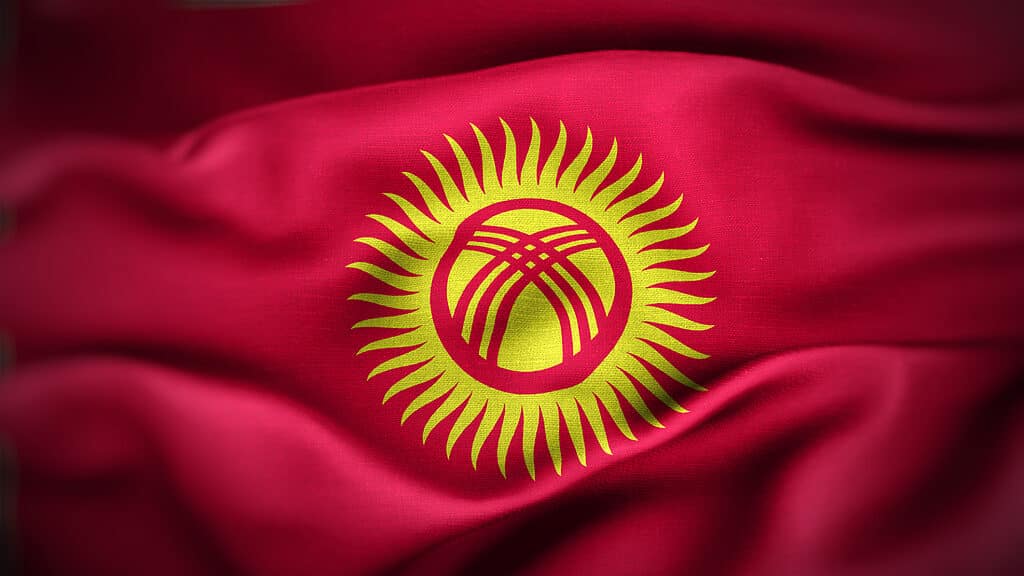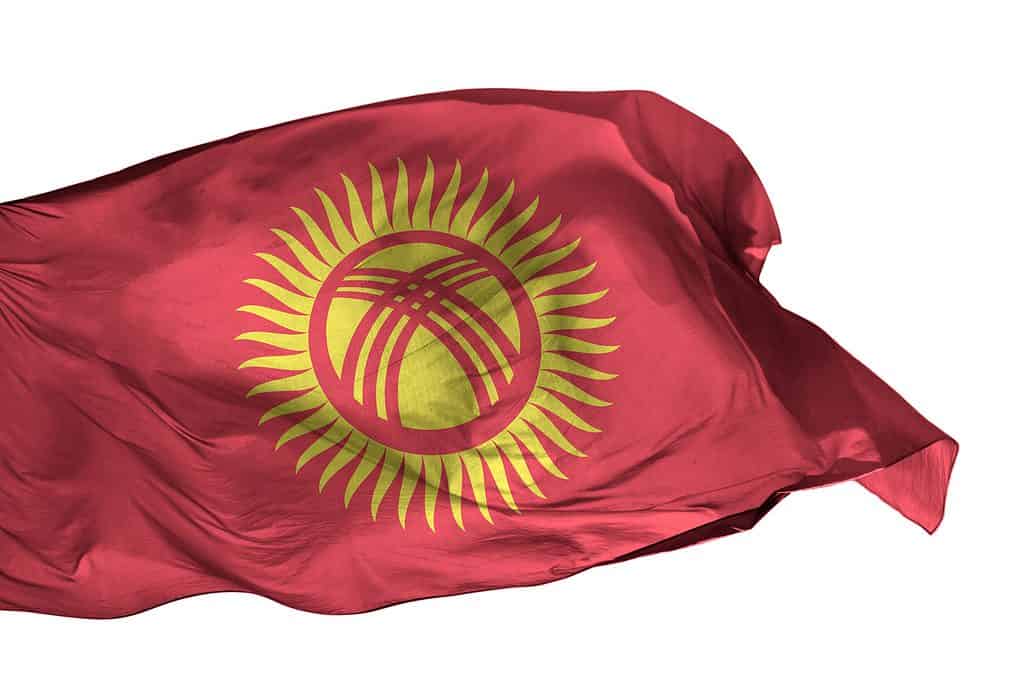Kyrgyzstan is a landlocked nation in central Asia that is geographically isolated due to its severely rugged terrain (it is completely encircled by land). The flag of Kyrgyzstan is referred to as “The State Flag of the Kyrgyz Republic.” Following the fall of the Soviet Union and the start of the country’s independence throughout the modern era, the current Kyrgyzstan flag was created. The flag was designed to appropriately portray Kyrgyzstan’s cultural heritage in order to symbolize the nation and its people. In this article, we will get to know the history, significance, and symbolism of the flag of Kyrgyzstan!
Flag of Kyrgyzstan History

The flag of Kyrgyzstan was last updated in 1992.
©Tatohra/Shutterstock.com
1898 – 1936
During the Andijan uprising in 1898, Kyrgyz revolutionaries waved a white banner that they called the “White Banner of National Liberation.” They used it once more in 1916, during the Central Asian uprising, the Jizzakh revolt, and a raid on Prebechakenska.
In 1924, the Soviets assumed control of Western Turkestan and promised equality and advancement for all ethnic groups. The Kyrgyz were granted their own autonomous region. In the USSR, it was given the status of an autonomous republic in 1926, and it was upgraded to a union republic in 1936.
1953 – Present Day
In 1953, under Soviet rule, the Union Republic, which included present-day Kyrgyzstan, flew a flag that was modeled after the flag of the Soviet Union and stood for Communism. Kyrgyzstan declared its independence on August 31, 1991, or just under four months prior to the dissolution of the Soviet Union. But for seven months following the declaration of independence, the Soviet-era flag was used as the nation’s flag.
The Kirghiz Soviet Socialist Republic (SSR) flag was replaced with the Kyrgyz Republic’s flag in 1992, several months after the country’s declaration of independence. It was finally changed to the present design on March 3, 1992, one day after Kyrgyzstan and seven other post-Soviet nations were admitted to the UN.
A recent commission to investigate options for modifying the present flag’s design was prompted in part by disputes about how to perceive the symbols on the current flag. The head of this group claimed that it served as a hub for conflict and polarization. The group claimed that the government did not wish for this national symbol to worsen the societal divide. But so far, nothing has been altered.
Flag of Kyrgyzstan Meaning
Design
The Kyrgyzstani flag consists of a crimson field with a yellow sun and 40 equally spaced sunrays. It includes an image of a tunduk, which is the opening in a typical nomadic tent. Every Kyrgyz yurt features a pinnacle. This consists of three crisscrossing laths that span the circular opening at the top of the yurt. It is the first thing a person notices upon waking up in a yurt and is represented in red stripes within the sun on the flag. The flag’s width-to-length ratio is around 3 to 5.
Flag of Kyrgyzstan Colors:
The colors red and yellow are the only colors that make up the Kyrgyzstani flag.
Flag of Kyrgyzstan Symbolism

The Kyrgyzstan flag represents many things such as peace, the people’s past, and the beginning of life.
©Tatohra/Shutterstock.com
There are several geographical, political, and historical meanings associated with the flag’s colors and symbolism. The red field signifies “bravery and heroism.” It corresponds to the purported flag carried by Manas, the celebrated national hero of Kyrgyzstan. The red field has also received a great deal of criticism. While some believe it is a remnant of communism in the country, others believe it reflects the nation’s volatile past.
The sun is a symbol of joy and peace. The Epic of Manas, one of the best literary masterpieces to come from Kyrgyzstan, is referenced by the 40 rays that radiate from the sun. The epic, an oral poem, told the story of Manas uniting the Kyrgyz tribes and fending off numerous foreign foes. The flag’s rays serve as both a symbol of the nation’s unity and a nod to its literary past.
The roof (tunduk), as seen from inside a traditional Kyrgyz tent (yurt), is stylized in the sun’s center. Despite the fact that they are less common today, the inclusion of these tents in the flag is meaningful. It is meant to signify the “beginning of life” and the “union of space and time,” in addition to the people’s past.
Up Next:
- The Ukrainian Flag: History, Meaning, and Symbolism
- The Flag of Libya: History, Meaning, and Symbolism
- The Flag of Liberia: History, Meaning, and Symbolism
The photo featured at the top of this post is © Misread/Shutterstock.com
Sources
- World Atlas, Available here: https://www.worldatlas.com/flags/kyrgyzstan
- Advantour, Available here: https://www.advantour.com/kyrgyzstan/flag.htm
- Kyrgyzstan Tourism, Available here: https://kyrgyzstan-tourism.com/blog/kyrgyz-flag/
Thank you for reading! Have some feedback for us? Contact the AZ Animals editorial team.






